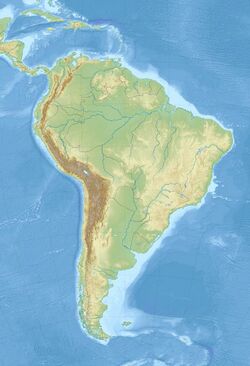Biology:Hondonadia
| Hondonadia | |
|---|---|
| Scientific classification | |
| Kingdom: | Animalia
|
| Phylum: | |
| Class: | Mammalia
|
| Infraclass: | Marsupialia
|
| Order: | |
| Suborder: | Bonapartheriiformes
|
| Family: | †Rosendolopidae
|
| Genus: | †Hondonadia Goin & Candela, 1998
|
| Type species | |
| †Hondonadia feruglioi Goin & Candela, 1998
| |
| Species | |
| |
| Synonyms | |
| |
Hondonadia is an extinct genus of Late Eocene to Early Oligocene (Tinguirirican) marsupials related to today's shrew opossums and with similar features as the related Rosendolops. The type species Hondonadia feruglioi was described by Goin and Candela in 1998.[1] In later years, five more species were recognized, of which Pascualdelphys fierroensis, described by Flynn and Wyss in 1999,[2] that was in 2010 synonymized with Hondonadia.[3]
Description
It was a small animal, with estimates of the body weight of the mammal ranging from 27 to 93.3 grams (0.95 to 3.29 oz). The species H. feruglioi and H. praecipitia were possibly larger. Its main diet probably consisted of seeds rather than insects.[4] The type species Hondonadia feruglioi preserves at least four upper incisors (of which the posteriormost is the smallest), but the presence of five teeth cannot be ruled out. H. feruglioi also preserves a very large, subvertical C1.[5]
Fossil distribution
Fossils of the genus were found in the Tinguiririca fauna of the Abanico Formation of Chile, the Santa Rosa local fauna of the Yahuarango Formation in Amazonian Peru and in the Gran Barranca fauna of the Vera Member pertaining to the Sarmiento Formation in Argentina.[6]
References
- ↑ Hondonadia in the Paleobiology Database
- ↑ Flynn & Wyss, 1999
- ↑ Goin et al., 2010
- ↑ Zimicz, 2014, p.111
- ↑ Beck, 2016, p.20
- ↑ Hondonadia at Mindat.org
Bibliography
- Beck, Robin M. 2016. The Skull of Epidolops ameghinoi from the Early Eocene Itaboraí Fauna, Southeastern Brazil, and the Affinities of the Extinct Marsupialiform Order Polydolopimorphia. Journal of Mammalian Evolution 24. 1–43. Accessed 2020-07-30.
- Zimicz, Natalia. 2014. New Paleogene Marsupials from the Amazon Basin of Eastern Peru. Ameghiniana 51. 106–128. Accessed 2020-07-30.
- Goin, Francisco Javier; María Alejandra Abello, and Laura Chornogubsky. 2010. Middle Tertiary marsupials from central Patagonia (early Oligocene of Gran Barranca): understanding South America's Grande Coupure in The Paleontology of Gran Barranca. Evolution and Environmental Change Through the Middle Cenozoic of Patagonia, 69–105. .; Cambridge University Press. ISBN 978-0-521-87241-6
- Goin, F. J., and A. M. Candela. 2004. New Paleogene Marsupials from the Amazon Basin of Eastern Peru. Natural History Museum of Los Angeles County, Science Series 40. 15–60.
- Flynn, J. J., and A. W. Wyss. 1999. New Marsupials from the Eocene-Oligocene transition of the Andean main range, Chile. Journal of Vertebrate Paleontology 19. 533–549.
Wikidata ☰ Q97959555 entry
 |


